Buyang Huanwu decoction facilitates neurorehabilitation through an improvement of synaptic plasticity in cerebral ischemic rats
- PMID: 28351388
- PMCID: PMC5371213
- DOI: 10.1186/s12906-017-1680-9
Buyang Huanwu decoction facilitates neurorehabilitation through an improvement of synaptic plasticity in cerebral ischemic rats
Abstract
Background: Loss of neural function is a critical but unsolved issue after cerebral ischemia insult. Neuronal plasticity and remodeling are crucial for recovery of neural functions after brain injury. Buyang Huanwu decoction, which is a classic formula in traditional Chinese medicine, can positively alter synaptic plasticity. This study assessed the effects of Buyang Huanwu decoction in combination with physical exercise on neuronal plasticity in cerebral ischemic rats.
Methods: Cerebral ischemic rats were administered Buyang Huanwu decoction and participated in physical exercise after the induction of a permanent middle cerebral artery occlusion. The neurobehavioral functions and infarct volumes were evaluated. The presynaptic (SYN), postsynaptic (GAP-43) and cytoskeletal (MAP-2) proteins in the coronal brain samples were evaluated by immunohistochemistry and western blot analyses. The ultrastructure of the neuronal synaptic junctions in the same region were analyzed using transmission electron microscopy.
Results: Combination treatment of Buyang Huanwu decoction and physical exercise ameliorated the neurobehavioral deficits (p < 0.05), significantly enhanced the expression levels of SYN, GAP-43 and MAP-2 (p < 0.05), and maintained the synaptic ultrastructure.
Conclusions: Buyang Huanwu decoction facilitated neurorehabilitation following a cerebral ischemia insult through an improvement in synaptic plasticity. Graphical abstract The Buyang Huanwu decoction (BYHWD) combined with physical exercise (PE) attenuates synaptic disruption and promotes synaptic plasticity following cerebral ischemia (stroke).
Keywords: Buyang Huanwu decoction; Cerebral ischemia; Neurorehabilitation; Synaptic plasticity.
Figures
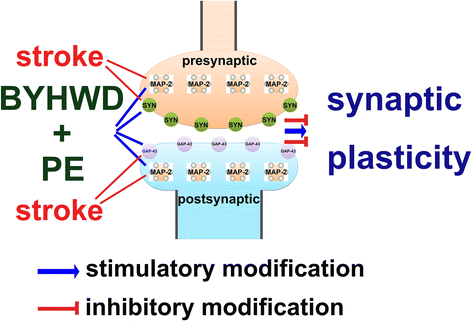
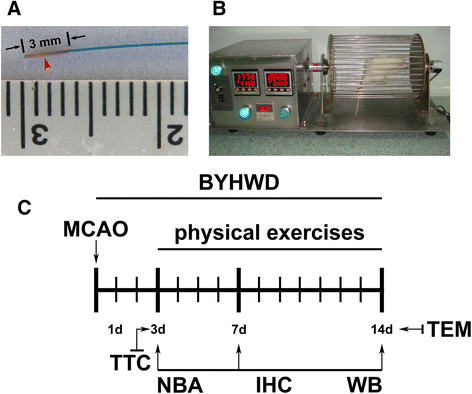
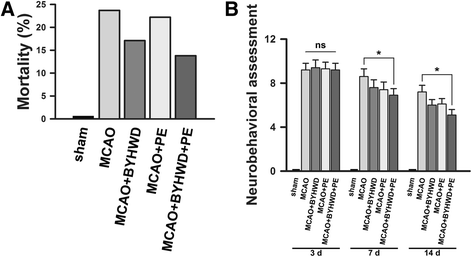
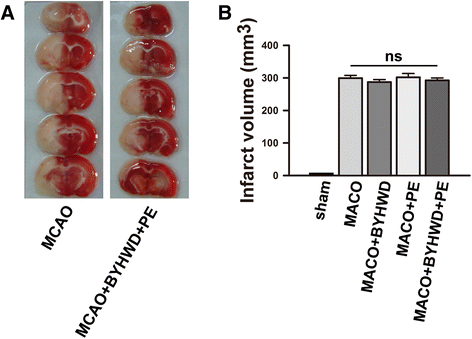
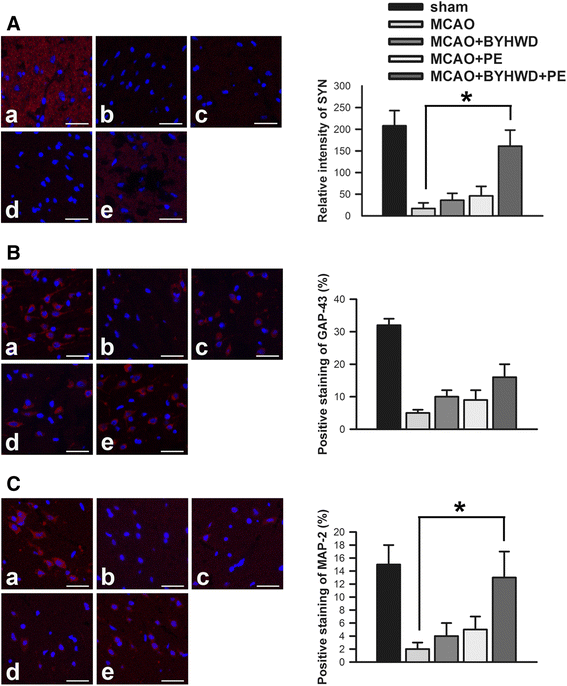
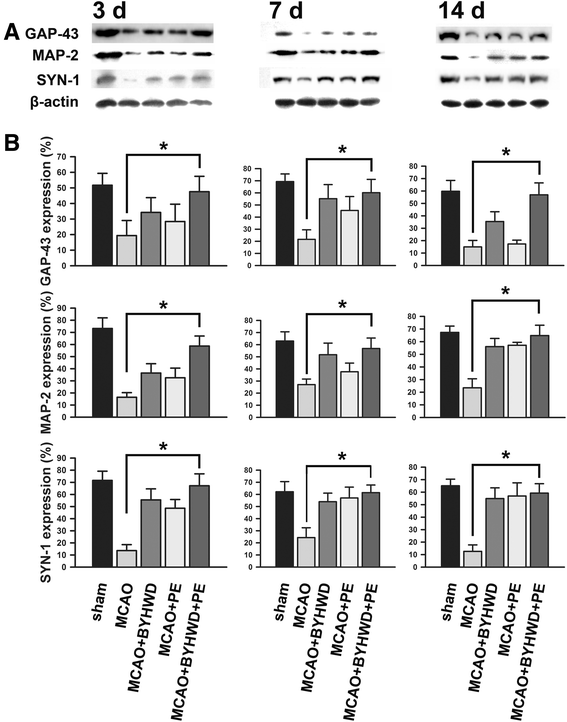

Similar articles
-
Buyang huanwu decoction improves synaptic plasticity of ischemic stroke by regulating the cAMP/PKA/CREB pathway.J Ethnopharmacol. 2024 Dec 5;335:118636. doi: 10.1016/j.jep.2024.118636. Epub 2024 Jul 30. J Ethnopharmacol. 2024. PMID: 39089658
-
[Buyang Huanwu Decoction attenuates cerebral ischemia-reperfusion injury in rats via miR-26a-5p mediated PTEN/PI3K/Akt signaling pathway].Zhongguo Zhong Yao Za Zhi. 2024 Aug;49(15):4197-4206. doi: 10.19540/j.cnki.cjcmm.20240515.501. Zhongguo Zhong Yao Za Zhi. 2024. PMID: 39307758 Chinese.
-
Neuroprotective effect of Buyang Huanwu decoction against focal cerebral ischemia/reperfusion injury in rats--time window and mechanism.J Ethnopharmacol. 2012 Mar 27;140(2):339-44. doi: 10.1016/j.jep.2012.01.026. Epub 2012 Jan 25. J Ethnopharmacol. 2012. PMID: 22306289
-
[Effects of Buyang Huanwu Decoction on neurovascular units after cerebral ischemia: a review].Zhongguo Zhong Yao Za Zhi. 2021 Oct;46(20):5226-5232. doi: 10.19540/j.cnki.cjcmm.20210610.706. Zhongguo Zhong Yao Za Zhi. 2021. PMID: 34738423 Review. Chinese.
-
Effect of Buyang Huanwu decoction for the rehabilitation of ischemic stroke patients: a meta-analysis of randomized controlled trials.Health Qual Life Outcomes. 2021 Mar 9;19(1):79. doi: 10.1186/s12955-021-01728-6. Health Qual Life Outcomes. 2021. PMID: 33750396 Free PMC article. Review.
Cited by
-
Protective Effect of Buyang Huanwu Decoction on Neurovascular Unit in Alzheimer's Disease Cell Model via Inflammation and RAGE/LRP1 Pathway.Med Sci Monit. 2019 Oct 18;25:7813-7825. doi: 10.12659/MSM.917020. Med Sci Monit. 2019. PMID: 31625533 Free PMC article.
-
The effects of Bu Yang Huan Wu Tang on post-stroke epilepsy: a nationwide matched study.Clin Epidemiol. 2018 Dec 10;10:1839-1850. doi: 10.2147/CLEP.S175677. eCollection 2018. Clin Epidemiol. 2018. PMID: 30573993 Free PMC article.
-
Curcumin protects neural cells against ischemic injury in N2a cells and mouse brain with ischemic stroke.Brain Behav. 2018 Jan 22;8(2):e00921. doi: 10.1002/brb3.921. eCollection 2018 Feb. Brain Behav. 2018. PMID: 29484272 Free PMC article.
-
Exploring the Oxidative Stress Mechanism of Buyang Huanwu Decoction in Intervention of Vascular Dementia Based on Systems Biology Strategy.Oxid Med Cell Longev. 2021 Mar 3;2021:8879060. doi: 10.1155/2021/8879060. eCollection 2021. Oxid Med Cell Longev. 2021. PMID: 33747352 Free PMC article.
-
The combination of Astragalus membranaceus extract and ligustrazine to improve the inflammation in rats with thrombolytic cerebral ischemia.Int J Immunopathol Pharmacol. 2019 Jan-Dec;33:2058738419869055. doi: 10.1177/2058738419869055. Int J Immunopathol Pharmacol. 2019. PMID: 31409163 Free PMC article.
References
-
- Cai G, Liu B, Liu W, Tan X, Rong J, Chen X, Tong L, Shen J. Buyang Huanwu decoction can improve recovery of neurological function, reduce infarction volume, stimulate neural proliferation and modulate VEGF and Flk1 expressions in transient focal cerebral ischaemic rat brains. J Ethnopharmacol. 2007;113(2):292–299. doi: 10.1016/j.jep.2007.06.007. - DOI - PubMed
MeSH terms
Substances
LinkOut - more resources
Full Text Sources
Other Literature Sources
Miscellaneous

